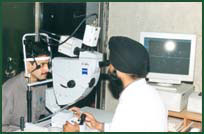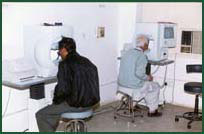Ultrasound Lab
- Details
- Last Updated on Thursday, 15 January 2015 17:45

Ultrasound Lab at R.P Centre
This lab houses the new Ophthalmic ultra sound machine - the new Ophthascan , along with the Roper Hall for detection of foreign bodies, Echo scan and Humphrey, A/B scan system, which has the facility of video print out.
Retina Lab
- Details
- Last Updated on Monday, 13 October 2014 14:36

Retina lab at R.P Centre
To facilitate comprehensive vitreoretinal examination a new Retina Lab has been set up which provides an opportunity to perform indirect ophthalmoscopy and three mirror examination at the out- patient level. It is quipped with the Dark Adaptometer, and the latest instruments used for colour vision testing like the Farnsworth Munsell 100 Hue test and Neigles Anomaloscope.
This houses the digital imaging system for retinal examination the Image Net. It provides most advanced database search and display capabilities in support of ophthalmological diagnosis and treatment. Non mydriatic Retinal Camera. This provides accurate retinal photographs for help in research, diagnosis and treatment.
Pharmacy and Dispensary
- Details
- Last Updated on Monday, 13 October 2014 13:23
Pharmacy at the Centre dispenses drugs to the patients admitted in wards and to the out patients. The Pharmacy Manufacturing Section manufactures eye drops under strict quality control measures using the modern technology of micropore filtration.
Glaucoma Lab
- Details
- Last Updated on Friday, 23 January 2015 12:02

Glaucoma Lab at R.P Centre
DR. Rajendra Prasad Centre for Ophthalmic Sciences is the apex institute in India for ophthalmic care. Glaucoma facility is one of the main pillars of R P Centre. It has been providing the best and most advanced ophthalmic care to the patients for 45 years. Glaucoma being a silent thief of sight is a disease and our centre has taken equal effort and commitment of the ophthalmologist in educating the public about the disease and its consequences .
Our Glaucoma facility has a unique infrastructure and is able to provide a lifelong care and follow up to patients since they are enrolled in our glaucoma clinic. We have 3 eminent faculty members in charge of the glaucoma services, with 3 glaucoma clinics a week and a glaucoma facility lab which runs all week days. Our specialty glaucoma clinic on an average provides services to 2500 new patients and 6300 old patients. Residents assist the faculty members in providing necessary care to the glaucoma patients. The glaucoma lab has 3 optometrists trained in ophthalmic investigations, especially pertaining to glaucoma .
The faculty in new glaucoma clinic confirms the diagnosis of glaucoma and initiates the treatment for the patients who were screened and referred from outpatient department. These patients are then followed up in the old glaucoma clinic as required. The glaucoma lab has all the advanced diagnostic modalities namely HRT. GDx,HVF,GVF,OCT,ASOCT, UBM, tonometer,keratometer, pachymeter.
Investigative modalities available at R.P.Centre:
1.Tonometry: this is a method to measure the intra ocular pressure. It can be done with various instruments each of which has its own limitations. Goldmann applanation tonometer is the gold standard modality. Every year approximately 16000 patients undergo this investigation at the glaucoma lab.
2. Pachymetry: this is a method to measure the corneal thickness. it helps to correctly estimate the intraocular pressure as it confounding factors which influences the pressure measured. On an average 5000 patients undergo this investigation every year.
3.Visual fields: Humphrey visual field examination is usually preferred to evaluate the patients who show progression in visual field defects over the years of followup and to tailor the treatment. Around 5400 patients obtain their visual field examination once or twice a year as advised by treating ophthalmologist every year. SWAP is another modality of visual field examination we have at our centre and approximately 50-100 patients obtain it yearly as per the indications.
4.Optic nerve head evaluation: it comprises of two aspects – the analysis of retinal nerve fiber loss and change in optic disc tomography. These investigative modalities help to diagnose glaucoma’s before a visual field loss ensues . The different modalities are OCT( optical coherence tomography); GDx or the scanning laser polarimetryand HRT ( Heidelberg Retina Tomograph) or a confocal scanning laser ophthalmoscope. Around 4800 patients undergo HRT and 2000 patients undergo GDx and 3000 undergo OCT yearly at the glaucoma lab.
5.Ultrasound biomicroscopy and Anterior segment OCT: These are new real time operating modalities with help to dynamically in vivo image the anterior segment of the eye and provide its anatomical and physiological changes. Yearly 360 patients undergo either of these investigations which helps in the diagnosis of pathophysiology of glaucoma..
Operation Theaters
- Details
- Last Updated on Monday, 13 October 2014 13:21
The Centre has a minor operation theatre for ward patients. The main operation theatres are equipped with all types of specialised instruments for surgery including keratoplasty, retinal detachment, ophthalmoplasty, squint, besides glaucoma, cataract etc. The operation theatre is equipped with operating microscopes and is fitted with a closed circuit T.V. system. Besides other operative appliances, it is also equipped for vitrectomy and lensectomy operations. Phaco emulsification is being used for cataract surgery. As a no stitch/one stitch technique is used, an earlier rehabilitation of patients is generally possible.
More Articles...
Subcategories
Contact Us
All India Institute of Medical Sciences
Ansari Nagar, New Delhi - 110029
Board Number : +91-11-26588500 / 26588700
Fax : +91-11-26588663 / 26588641




